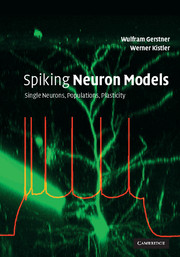1 - Introduction
Published online by Cambridge University Press: 05 June 2012
Summary
The aim of this chapter is to introduce several elementary notions of neuroscience, in particular the concepts of action potentials, postsynaptic potentials, firing thresholds, and refractoriness. Based on these notions, a first phenomenological model of neuronal dynamics is built that will be used as a starting point for a discussion of neuronal coding. Due to the limitations of space we cannot – and do not want to – give a comprehensive introduction into such a complex field as neurobiology. The presentation of the biological background in this chapter is therefore highly selective and simplistic. For an in-depth discussion of neurobiology we refer the reader to the literature mentioned at the end of this chapter. Nevertheless, we try to provide the reader with a minimum of information necessary to appreciate the biological background of the theoretical work presented in this book.
Elements of neuronal systems
Over the past hundred years, biological research has accumulated an enormous amount of detailed knowledge about the structure and function of the brain. The elementary processing units in the central nervous system are neurons which are connected to each other in an intricate pattern. A tiny portion of such a network of neurons is sketched in Fig. 1.1 which shows a drawing by Ramón y Cajal, one of the pioneers of neuroscience around 1900. We can distinguish several neurons with triangular or circular cell bodies and long wire-like extensions.
- Type
- Chapter
- Information
- Spiking Neuron ModelsSingle Neurons, Populations, Plasticity, pp. 1 - 28Publisher: Cambridge University PressPrint publication year: 2002
- 5
- Cited by



